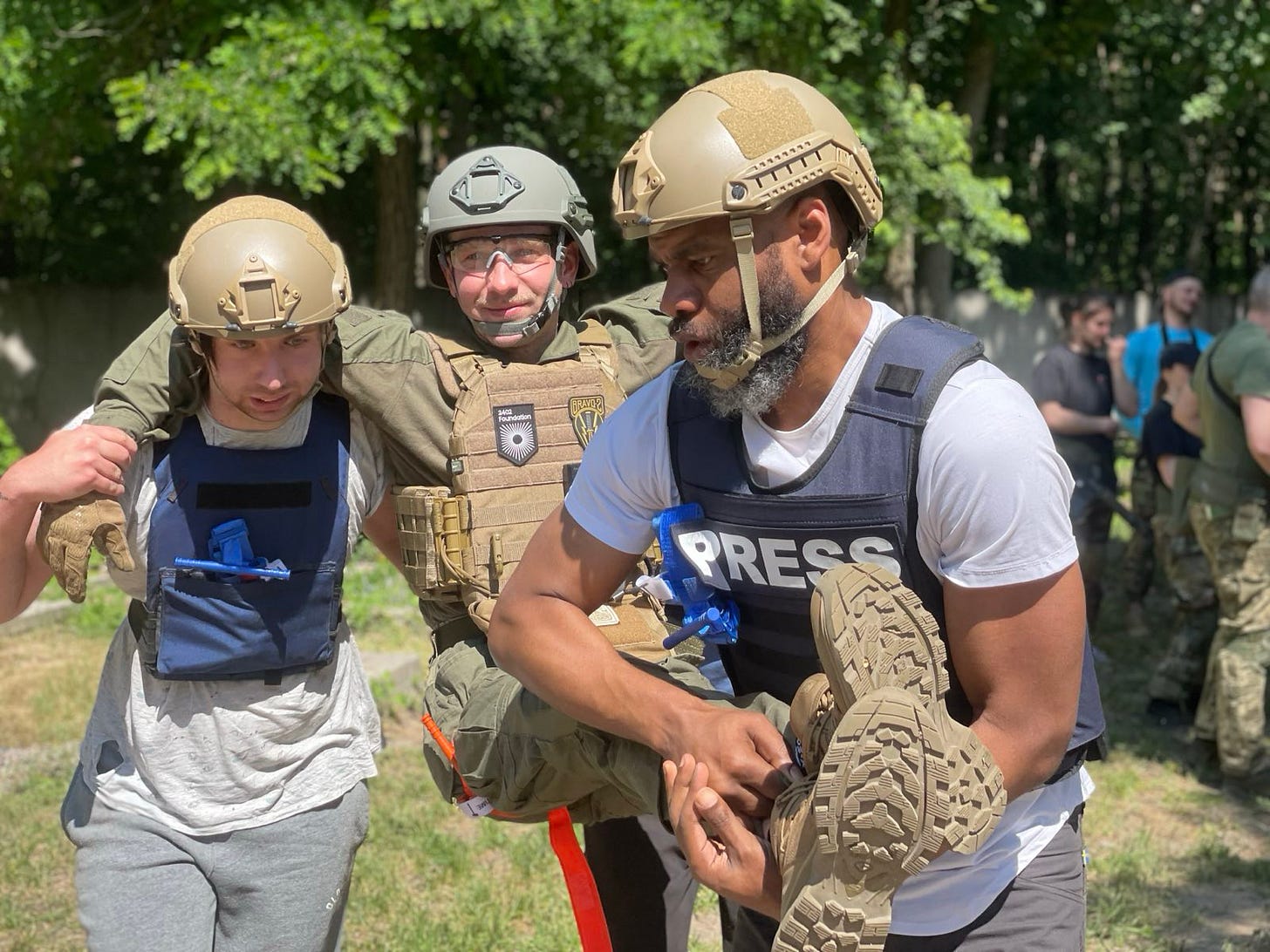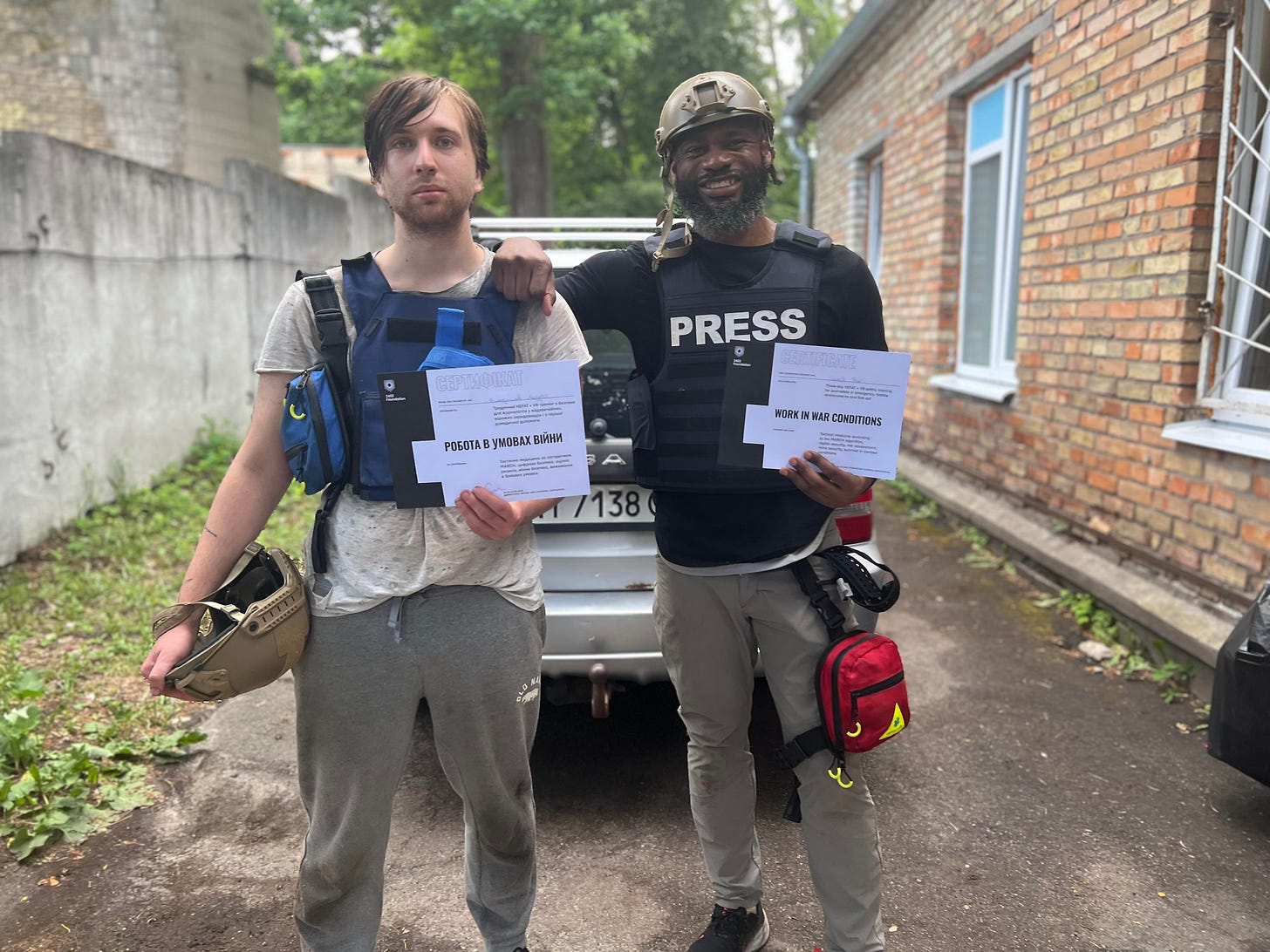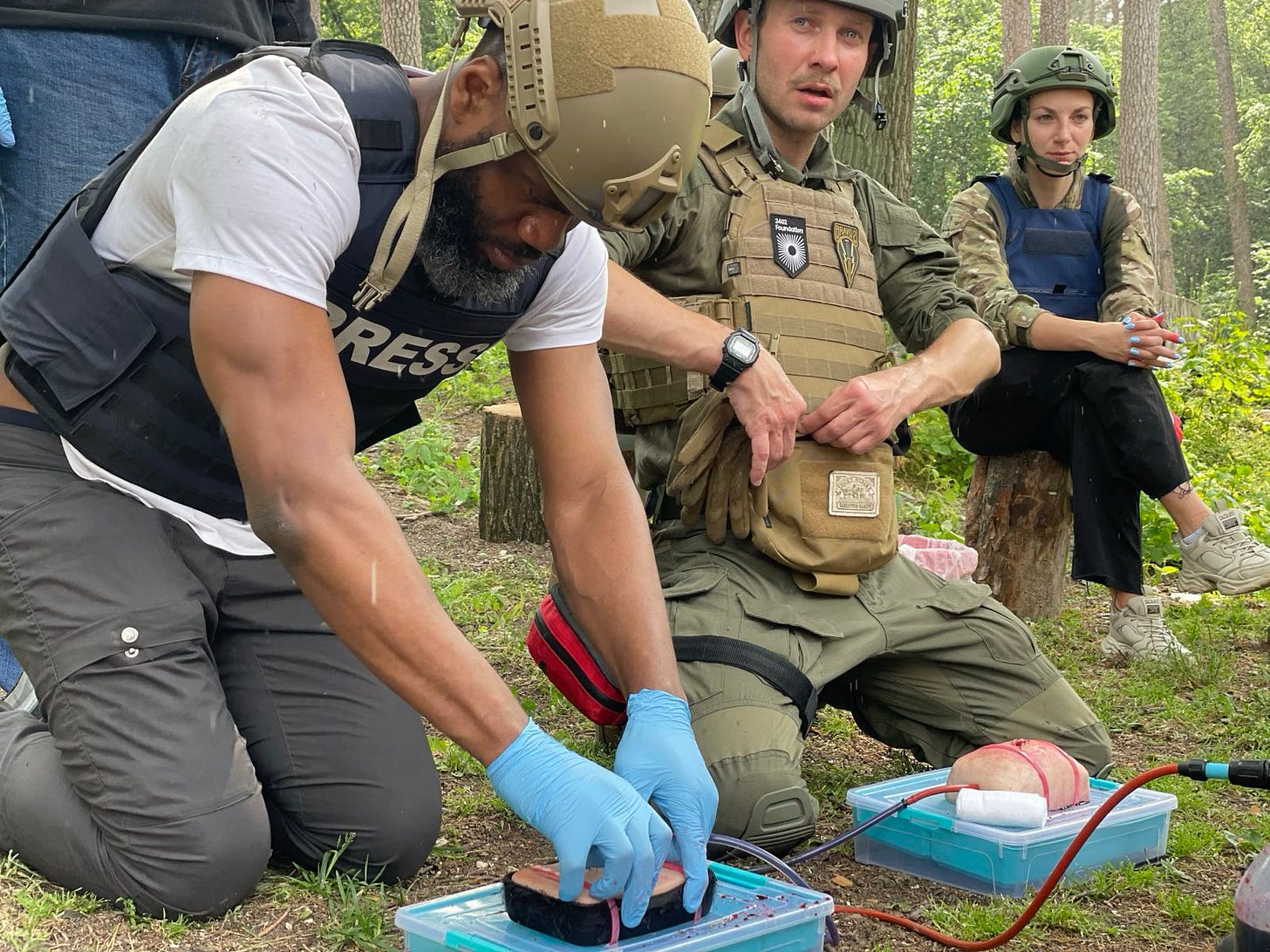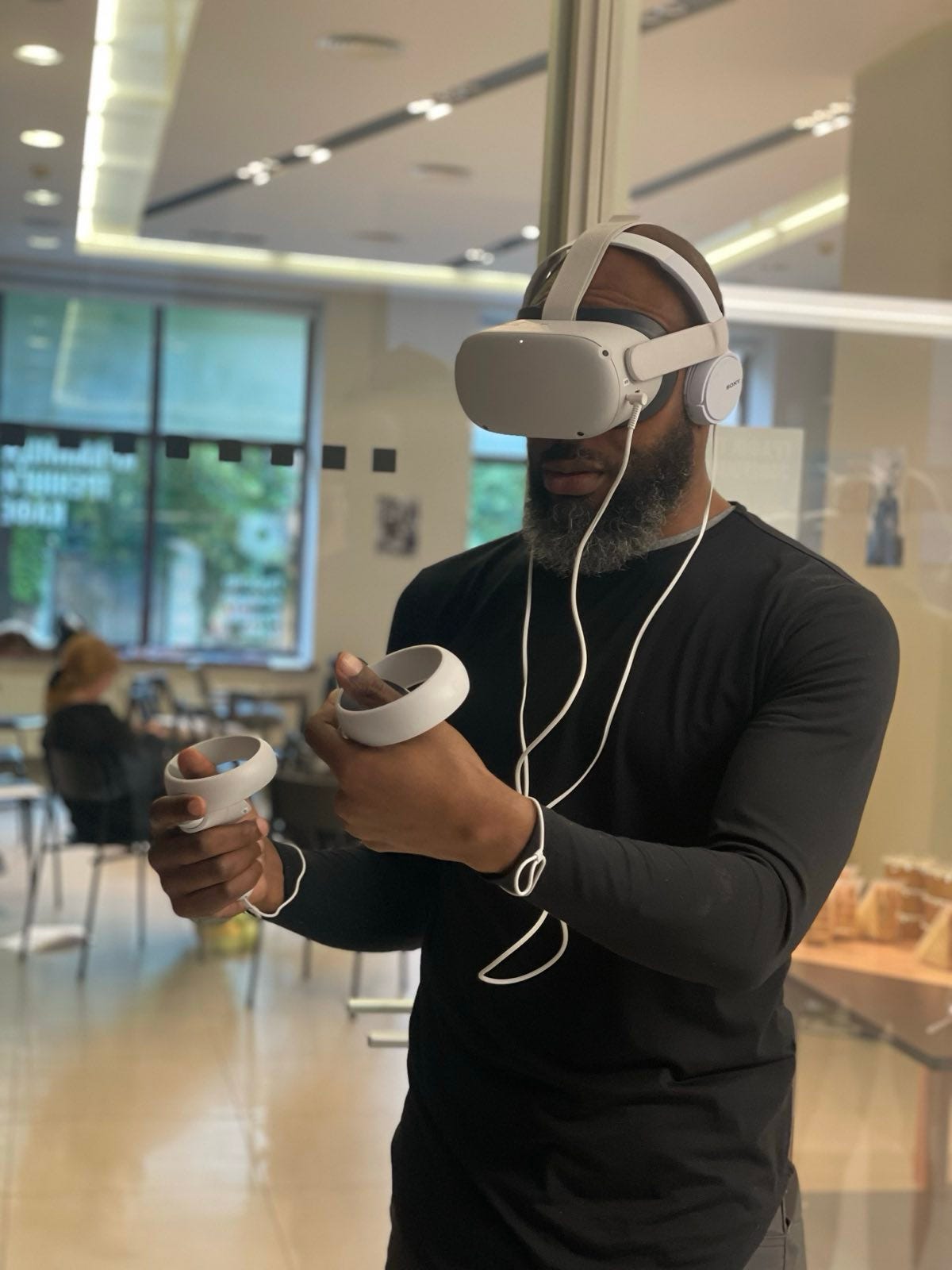How Ukrainian Journalists (And Me) Train to Cover the War
Yes. You actually need to train for this shit!

NOTE 2402 Foundation is hosting a two-day training on first aid in Kyiv June 29-30. If you’re around, sign up here. You’ll need to donate 1500 to 3000 UAH to support the training costs. It’s 100 percent worth it and a fraction of what you’d pay in the West.
Katerina Sergatskova experience covering war came soon after Russia displaced her out of her childhood home in Simferopol during its illegal annexation of Crimea in 2014. Like so many Ukrainian reporters, Sergatskova didn’t pursue war reporting.
They were literally forced to.
She and other Ukrainian reporters would risk their lives covering Russia’s invasion from that point forward on to 2022, introducing the world to the most devastating violence of Russian dictator Vladimir Putin’s occupation of Ukraine.
But one glaring issue came up: neither Sergatskova nor her colleagues had any training on first aid, threat assessment, communications, best practices on digital security and other essential skills to report from war zones. So, in 2022, she an her colleague Roman Stepanovych founded 2402 Foundation, a Ukrainian-run organization created to help reporters better take care of themselves as they reported on the Russian invasion.
“I cannot count how many times I was about to end up in prison, being beaten or even dead,” Sergatskova, also the foundation’s executive director, told me. “So you don't realize it until you see the consequences on other people. We were learning by doing in pretty dangerous environments. So when the (full-scale) invasion started, my partner and I immediately thought that we needed to do something for our colleagues because there were thousands of journalists without any war experience, even though we had eight years of war.”
Hundreds of journalists have taken the foundation's various training sessions. While the courses prioritize Ukrainian reporters, foreigners are allowed to participate. Fifty percent of the participants are full-time employees with media organizations and the other half are freelancers, like me. Such training can easily cost thousands of dollars per person. Big media companies like The New York Times and the BCC pay the tab for their employees. It’s not uncommon for mainstream media reporters to go into conflict zones in armored vehicles with hired security companies that charge thousands of dollars per day.
We’ve grown used to the television footage of reporters embedded with soldiers fighting in conflicts around the world. The raw footage draws people in to the brutality of war. But those scenes that most people watch from the comfort of their homes come at great personal risk to the reporters who dare to document them.
According to the National Union of Journalists of Ukraine, at least 91 media workers have been killed since Russia's full-scale invasion. For those who aren’t killed, many are wounded, have gone missing or being held in captivity. The Institute of Mass Information reports that Russia is responsible for nearly 600 crimes against journalists since 2022.
Like Sergatskova, I didn’t know jack about covering war, either.
All I had was my iPhone, street smarts and the helmet and flak jacket my buddy gave me when he and his fellow soldiers let me embed in their Territorial Defense Forces (TDF) unit at the start of the 2022 Russian invasion. Within a matter of days, I saw soldiers shoot and kill suspected saboteurs trying to speed past a checkpoint after ignoring demands to stop and survived a Russian missile strike on that same checkpoint a day later.
Like most people covering war, I learned on the fly.
I knew immediately that I had the mettle to do this work. But, like Sergatskova and her Ukrainian colleagues, I didn't have the essential skills to take care of myself when shit hit the fan. That’s why I enrolled in one of 2402’s three-day-hostile environment courses for war reporters. Since the training was all done in Ukrainian, a language I am still learning, my buddy Vladyslav Starodubtsev served as my translator.

It was the most intense educational experience of my life. The first day included lectures from professionals who recalled their experiences working at the front. We also watched videos of reporters fucking up and got tips on how we shouldn’t make the same mistakes, got some digital security safety training and went through a virtual reality session that simulated civil unrest.
The next two days were much more intense and physically taxing.
We were taken to an undisclosed location that resembled the type of environments we’d find ourselves in near the frontlines in Ukraine: urban terrain littered with shards of broken glass, trenches, gutted out buildings and the constant threat of something exploding around you. (the explosions were simulated and not live rounds)
We learned how to apply a tourniquet and gauze to massive bleeding spots on practice dummies, check for breathing, clear air flows and other critical first aid care. Then we practiced on our fellow trainees throughout the day. Instructors would toss fake explosive devices without warning, testing how well we knew to seek cover.
Imagine doing burpees, but in an improvised war environment.

This was a great experience because you learn how to fall on the ground and what to look out for. I almost bludgeoned myself on a piece of tree trunk sticking out of the ground and nearly cut my hands on the broken glass. Bullets and shrapnel aren’t the only dangers in these environments.
We worked in teams throughout the training, so you get to see how your colleagues react to stress. Some people winced when we were shown a badly wounded person during presentations, which sometimes ended suddenly because of power outages—a common occurrence in Ukraine. Some of the exercises involved us having to carry each other 100 meters or more to safety because we had to practice caring for an injured colleague.
I go to the gym six times a week and I can tell you that gym weights aren’t the same as someone’s body weight. It’s good to know how far you can carry your colleague under duress.
The real benefit you get from the three days is knowing if you are actually built for this line of work. Some people realize they aren’t.
“That's the best feedback you would ever wish for,” Sergatskova said. “Because people finally realize that they are not meant for this job and if they will be (in the conflict zone) and there will be a serious situation, it can end very badly. So it's important that people realize for themselves that they don't want to be this guy who would get others in trouble.”
Oleksii Prodaivoda, a news and documentary journalist, told me that he and his colleagues completed 2402’s training recently and said it was helpful. In fact, Prodaivoda suggests that reporters going to the front should take such courses every three months to maintain their skills.
Emmanuelle Chaze, an independent reporter who has been in Ukraine since the 2022 invasion, came with years of experience covering migration and war reporting conflict training. It took her a few months to go to the front because she wasn’t ready to take on the risk. Chaze felt she needed to understand the terrain, get a handle on the language and a better understand of the people first.
Other independent reporters she came across weren’t as thoughtful.
“I saw so many freelancers crossing the border and telling me, ‘Yeah, let's go to Donbas.’ And I'm like, ‘Do you speak Ukrainian? Do you speak Russian? Do you have insurance? Do you have a flak jacket? Do you have a helmet? Do you know what to do if you're injured?,” she recalls.

Chaze went when she was ready. The newsrooms she works for don’t pressure her to take unnecessary risks and that gives her time to decide which stories are worth taking risks—and which ones aren't.
But even when you analyze the risks and decide it’s safe to go somewhere, you really aren’t safe. War reporting will always come with dangers no matter how careful you are. As someone who lives in Ukraine and is preparing to go to the front soon, I think the best thing war correspondence training does is empower you with skills to take are of yourself when things get bad.
Whether the story is worth the risk is subjective.
“It depends on your personal courage,” Chaze said in agreement. “When I'm (near the frontline), everything makes sense to me. But I'm sure it's not the case for everyone. For example, I was near Volchansk doing evacuation stories recently. We were hearing outgoing artillery and seeing helicopters. It was definitely not safe at all and I knew it. But at the same time, when you are there, you have those people who talk to you and trust you with their stories. Ultimately you stay for those. That's my motivation.”
We also have to factor in the psychological trauma this war brings to most Ukrainians, including journalists. Many of them are like Sergatskova: displaced from their homes and have loved ones who have been harmed one way or the other from this invasion. The United Nations Office for the Coordination of Humanitarian Affairs reports that one-third of households in Ukraine have at least one family member dealing with some type of mental health issue.
“I have a privilege because I can travel outside of the country,” Sergatskova said. “For men, it's much, much harder because they can’t, which is really crucial to refresh yourself and get out of the traumatic, hostile environment. So it's important and we female journalists can do that. We can even live outside the country and still be able to work as journalists, which is not relevant for male journalists who have to be inside the country to continue reporting.”
(Sergatskova says 2402 is figuring out ways to provide mental health support for Ukrainian journalists)
As a foreigner, I can come and go out of Ukraine at my leisure. (I’m literally finishing up this article in Berlin!) Locals journalists carry the burdens of reporting this war that folks like me never have to consider. So it’s good to keep that in mind that, no matter how well international medias report on this invasion, it’s the homegrown Ukrainian media workers who are sacrificing their mental health and suffering personal loses covering this invasion.
We should never forget that.
That said all war reporters are a special breed. You can have all of the training you want, but I think you have the stomach for it. Either you have it in you to endure the emotional and physical grit of the work or you don’t. Sure, you have some ego-driven cowboys and thrill-seekers out there who come to Ukraine to get a photo for Instagram.
But most people do this work because they care. I don’t have to live in Ukraine and cover this war. But I need to be here because I’m called to do this work. Sounds pretty self-righteous, I know, but it’s true.
As violent as war reportering is, someone has to show the world what Russia is doing to Ukraine. And that job mostly sits on the shoulders of Ukrainian journalists and folks like me who come in and contribute what we can to help expose the violent realities of Russia’s barbaric invasion.
Sergatskova is just happy foundations like hers are around to provide training that wasn’t available for reporters like her ten years ago.
“You can’t have enough knowledge and skills,” Prodaivoda told me. “Especially during the war.”




